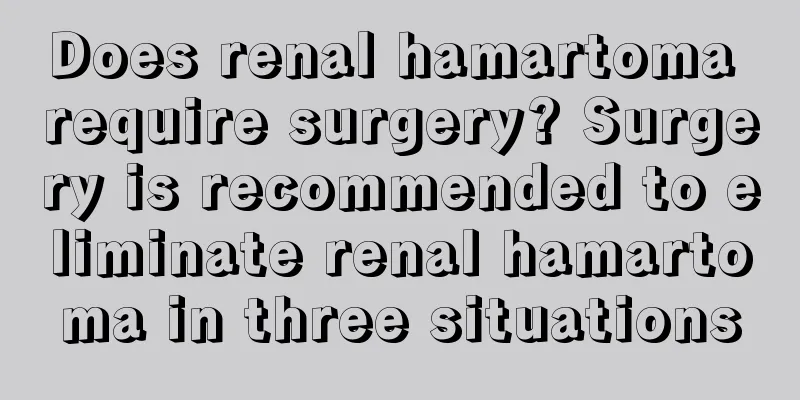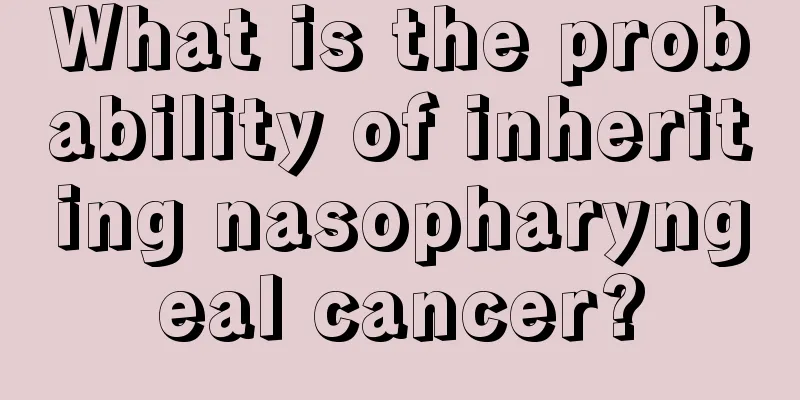Does renal hamartoma require surgery? Surgery is recommended to eliminate renal hamartoma in three situations

|
Renal hamartoma is a benign tumor, so when the tumor is small and does not affect daily life, conservative treatment can be performed, and regular check-ups at the hospital are required. Pay more attention to daily life, eat a reasonable diet, maintain a regular work and rest schedule, and strengthen exercise. However, when the renal hamartoma is large, compresses and invades surrounding organs, or ruptures and bleeds, surgery is recommended as soon as possible. Since renal hamartoma is a benign lesion, most cases have a good prognosis after surgical resection. However, some cases do not require surgery because the tumor is small and does not affect normal life. Clinically, it is necessary to choose an appropriate treatment plan based on the condition, the size of the tumor, whether the tumor is found to be invasive or bleeding, etc. So does renal hamartoma require surgery? In which three situations is surgery recommended to eliminate renal hamartoma? Treatment principles Tumors <4 cm are not treated; giant renal hamartomas may be treated with nephrectomy. Treatment strategy Tumors <4 cm may not require treatment, but close follow-up is required. Tumors <5 cm may require enucleation; giant renal hamartomas may require nephrectomy. Surgery 1. Nephron-sparing surgery Tumors <5 cm can be enucleated, especially those at the edge of the kidney. For cases with smaller tumors, laparoscopic nephron-sparing partial nephrectomy (LpN) is an effective surgical treatment. 2. Nephrectomy Giant renal hamartomas can be treated with partial or complete nephrectomy. If the disease is bilateral, more consideration should be given to the preservation of renal function. In a few cases, there may be local and lymph node invasion, or even tumor thrombus invasion of large veins, showing malignant behavior, and radical nephrectomy should be performed. Other treatments 1. Embolism Arterial embolization should first be considered in cases of bleeding. According to experience, the volume of the tumor does not decrease after embolization, but the bleeding can be stopped. Superselective renal artery branch embolization is often used to protect some renal function. 2. Kidney transplantation or hemodialysis It is only suitable for patients who must undergo bilateral nephrectomy due to bilateral lesions leading to renal failure or tumor rupture and bleeding. Prognosis Unilateral renal hamartoma is a benign lesion with a good prognosis. Bilateral, multiple lesions and renal insufficiency still affect the quality of life despite conservative treatment. In a few cases where multiple organs are invaded, such as lymph nodes, brain, heart, or even blood vessels, the prognosis depends on the degree and range of the invaded organs. |
<<: Early symptoms of throat cancer in women
>>: Will renal hamartoma continue to grow?
Recommend
What are the side effects of acupuncture therapy?
Acupuncture knife therapy is a treatment method b...
There are horizontal lines on the nails, it may be these problems
It is very common to see horizontal lines on the ...
How many oral medicines are there for rectal cancer
Rectal cancer is caused by the malignant transfor...
Can bladder cancer be inherited by offspring?
Individuals who have a parent or sibling with bla...
Skin cancer patients must take timely treatment methods
In recent years, the incidence of skin cancer has...
What are the symptoms of early liver cirrhosis
The liver is the largest detoxification organ in ...
What is the reason for middle-aged people to lose teeth
As we all know, the importance of teeth to the hu...
How to slow down your heart rate
When your heart rate is too fast, it is not only ...
Can thyroid cancer cause itchy throat and cough?
Yes, thyroid cancer may cause an itchy throat and...
Why is my vest cold?
Many times, some more detailed symptoms are often...
How to effectively prevent bladder cancer
With the development of society, bladder cancer i...
How to use medicine for malignant teratoma
How to use medicine for malignant teratoma? Terat...
How do you get stomach problems
Many chronic diseases are tormenting people. If t...
What is the correct order for using sunscreen
In summer, it is more important to protect your s...
What causes chest pain?
Female friends need to pay attention to chest pai...









